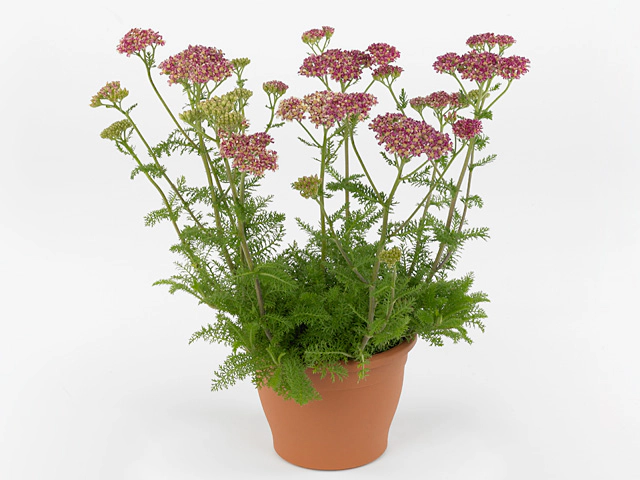Achillea millefolium Desert Eve Deep Rose

| Flower scent | Unpleasantly smelling |
| Winter hardness | Good (USDA-zone 5, 6) |
| Flower color | Red-dark purple-060C |
| Soil fertility | Not very demanding |
| Leaf, general shape | Elongate; Lanceolate |
| Flower diameter | 1 - 10 mm |
| Plant height | 20 - 30 cm; 30 - 40 cm |
| Inflorescence | Corymb (ramose) |
| Flowering month(s) | June; July; August; September; October |
| Leaf size | 5 - 7,5 cm |
| Light conditions | Sunny |
| Leaf division | Pinnate |
| Inflorescence diameter | 5 - 10 cm |
| Leaf, main color | Dark green |
| Flower color distribution | Unicolored |
| Moisture requirements | Well-drained |
| Soil type | Sandy; Humus rich; Clayish; Sandy clay |
Achillea millefolium, commonly known as yarrow or milfoil, is a versatile and hardy perennial plant that thrives in various soil types and climate conditions. One particular variety of yarrow, called Desert Eve Deep Rose, boasts stunning red-dark purple flowers and a multitude of other characteristics that make it a popular choice among gardeners.
One distinguishing feature of the Desert Eve Deep Rose yarrow is its unpleasant scent. While the flowers are visually appealing, their fragrance might not be to everyone's liking. However, this scent does not deter from the overall beauty and charm of the plant.
Winter hardiness is an important trait for gardeners, especially in regions with colder climates. The Desert Eve Deep Rose yarrow has good winter hardiness, thriving in USDA zone 5 and 6. This means that it can withstand freezing temperatures and continue to bloom and thrive even in harsh winter conditions.
With elongated lanceolate leaves and a plant height ranging from 20-40 cm, the Desert Eve Deep Rose yarrow adds a touch of elegance to any garden. Its pinnately divided leaves are a dark green color, providing a beautiful contrast to the vibrant flowers.
Speaking of flowers, the Desert Eve Deep Rose yarrow produces small flowers with a diameter ranging from 1 to 10 mm. These flowers are clustered in corymb inflorescences, creating a striking visual display. The inflorescence itself has a diameter of 5-10 cm, making it a focal point in any garden or floral arrangement.
The flowering period for the Desert Eve Deep Rose yarrow spans from June to October, ensuring that it provides vibrant color throughout the summer and into the early fall. This extended blooming period makes it a valuable addition to any garden, as it brings life and brightness for several months.
In terms of soil fertility, the Desert Eve Deep Rose yarrow is not very demanding. It can thrive in sandy, humus-rich, clayish, and sandy clay soils, making it adaptable to various garden environments. This versatility makes it suitable for a wide range of gardeners, whether they have nutrient-rich soil or more challenging soil conditions.
Light conditions are also crucial for yarrow, and the Desert Eve Deep Rose variety prefers sunny spots. Placing it in an area that receives ample sunlight throughout the day will help it reach its full potential and enhance the intensity of its flower color.
Moisture requirements for the Desert Eve Deep Rose yarrow include well-drained soil. It does not tolerate waterlogged conditions, so ensuring proper drainage is essential for its overall health and longevity. Watering should be done sparingly, allowing the soil to dry slightly between waterings.
Overall, the Desert Eve Deep Rose yarrow is a stunning and low-maintenance perennial plant. Its visual appeal, extended blooming period, and adaptability to different soil types make it an excellent choice for both experienced gardeners and beginners. Whether used in borders, rock gardens, or as cut flowers in floral arrangements, this yarrow variety adds a touch of elegance and beauty to any landscape.
Market availability index by month:
| Jan. | Feb. | Mar. | Apr. | May | Jun. | Jul. | Aug. | Sep. | Oct. | Nov. | Dec. |
|---|---|---|---|---|---|---|---|---|---|---|---|
| - | - | 2 | - | 2 | 4 | 1 | 1 | 1 | - | - | - |